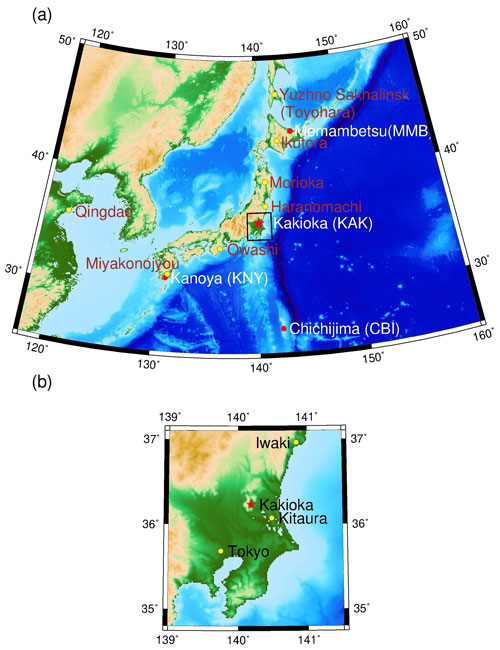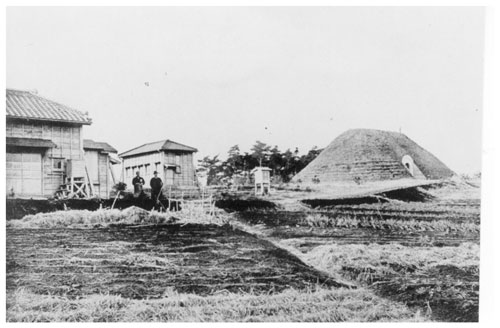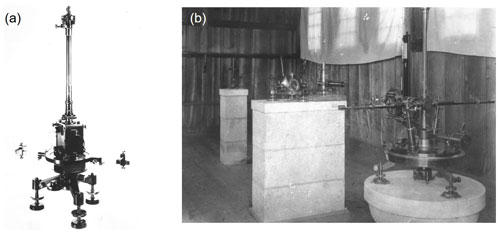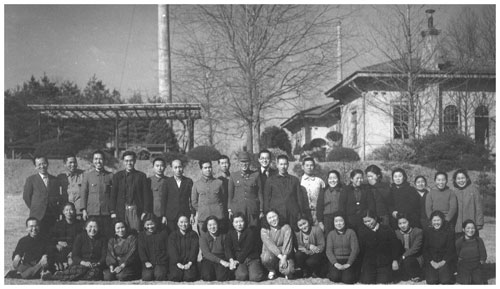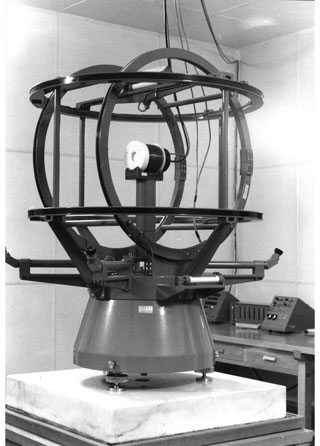the Creative Commons Attribution 4.0 License.
the Creative Commons Attribution 4.0 License.
History of Kakioka Magnetic Observatory
Shingo Nagamachi
Kakioka Magnetic Observatory (KMO) was founded in 1913 by the Central Meteorological Observatory (CMO, later the Japan Meteorological Agency) as a successor to Tokyo Magnetic Observatory. Kakioka was a village 70 km north of Tokyo and was selected to escape from tram noise in Tokyo. At first, it was an unstaffed observatory only for geomagnetic field observation. Then, the Great Kanto Earthquake in 1923 changed the fate of KMO because the earthquake severely damaged the CMO in Tokyo, and recording papers of KMO were lost. KMO was staffed in 1924 and was redesigned as an institute for geophysics rather than geomagnetism. KMO operated a variety of observations, such as the atmospheric electric field, the geoelectric field, the seismicity, the air temperature, the wind velocity, the sunspot and solar prominence as well as the geomagnetic field, by the 1940s. In addition, research activity flourished with the leadership of the first director, Shuichi Imamichi. After World War II was over in 1945, KMO formed a network of observatories in Japan by founding several branch observatories originally for geoelectric field observation. Two branch observatories at Memambetsu and Kanoya survived, with geomagnetic field observation added in the International Geophysical Year project (1957–1958). Efforts in development of instruments for geomagnetic absolute measurement and systems of high-sampling recordings in the 1950s to 1970s resulted in the development of the Kakioka Automatic Standard Magnetometer (KASMMER) system in 1972. KASMMER measured the geomagnetic field every 3 s at the highest standard in the world in digital form, giving 1 min digital values of the geomagnetic field available. This system has been updated, and the high-sampling technology was applied to geoelectric field observation and atmospheric electric field observation. Later, adding geomagnetic field observation at Chichijima in 1971, KMO established a unique electric and magnetic observation network at Kakioka, Memambetsu, Kanoya and Chichijima and provided precise and high-speed sampling data (1 min, 1 and 0.1 s values) by 2001. On the other hand, KMO gradually terminated or automated their observations and reduced their staff in the last several decades following the government's reform policy. The two branch observatories at Memambetsu and Kanoya were unstaffed in 2011, and the atmospheric electric field at Memambetsu was terminated at that time. The geoelectric field observations at Kakioka, Memambetsu and Kanoya were terminated in 2021 as well as the atmospheric electric field at Kakioka. KMO focuses on geomagnetic observation for now and puts efforts into total force observation at volcanoes and the digitization of historic analog data.
- Article
(22064 KB) - Full-text XML
- BibTeX
- EndNote
Kakioka Magnetic Observatory (KMO) is one of the longest-serving geomagnetic observatories in the world and is the longest-serving in East Asia. It has established a unique reputation through its scientific and technological achievements.
It was founded by the Central Meteorological Observatory in 1913 at Kakioka, which is about 70 km north of Tokyo, as a successor to Tokyo Magnetic Observatory (Fig. 1), because Tokyo Magnetic Observatory was influenced by tram noises. KMO regularly has observed not only the geomagnetic field, but also the atmospheric electric field, geoelectric field, earthquakes and weather elements for more than a century at Kakioka. In addition, KMO has operated the Memambetsu, Kanoya and Chichijima observatories for more than 60 years (Fig. 1). Most of its digital data are freely downloadable from the data site of KMO's webpage (http://www.kakioka-jma.go.jp/obsdata/metadata/en, last access: 10 August 2022).
This article describes the history of KMO. Some articles have already documented the history of KMO (Imamichi, 1938a; Japan Meteorological Agency, 1975; Kakioka Magnetic Observatory, 1983; Imamichi, 1983; Kakioka Magnetic Observatory, 1999; Minamoto 2010; Kawamura, 2013). Among them, Kakioka Magnetic Observatory (1983, hereafter KMO1983) is the most comprehensive work, and an early part of KMO's history in the present article mostly refers to KMO1983. Kakioka Magnetic Observatory (1999) summarizes the history of KMO's branch observatories (Memambetsu and Kanoya) during the 20th century.
Early records of the geomagnetic field in Japan can be known from historical documents from the 17th to 19th centuries, such as field notes by Tadataka Ino, who made the first realistic map of Japan in 1800–1816, cruise records (Shinozaki, 1938), and notes by local scientists (Imamichi, 1956). Kato (1983) pointed out that Masamune Date, a famous warlord in the 17th century, constructed several buildings facing geomagnetic north. Those were short-lived observations, and often only the declinations were observed.
Modern-style continuous observations of the geomagnetic field in Japan were started in 1882–1883 in anticipation of the First International Polar Year (1882–1883). Antoine Henri Becquerel, who represented Japan at the 1st International Electrical Congress in Paris in 1881 and later famously discovered radioactivity, invited Japan to participate in the Polar Year activity, and the Japanese government decided to accept. Later, three national institutions separately started geomagnetic observations in Tokyo in 1882–1883. One of the three institutions is the Geographical Bureau of the Ministry of the Interior in cooperation with the Telegraph Bureau of the Ministry of Industry. The Geographical Bureau of the Ministry of the Interior had a division that was in charge of observations of weather and the atmospheric electric field. They made a magnetometer by themselves and started geomagnetic observations at a property of the Ministry of Industry at Aszabu chou in Tokyo from 15 March 1883. The annual report of the Geographical Bureau for 1885 stated that the observation was conducted every hour for the first 6 months and then eight times a day (KMO1983). A part of the data in 1883 can be seen in Knott and Tanakadate (1888).
The other two observations were conducted by the Hydrographic Bureau in the navy (Hydrographic Bureau, 1883) and the Geological Survey of Japan (Supporting Group for Centennial Anniversary of Geological Survey of Japan, 1983). Those observations had several interruptions after the First International Polar Year, but they are still ongoing today as magnetic surveys in the ocean by the Japan Coast Guard and magnetic surveys on land and continuous observations of the geomagnetic field at 14 sites by the Geospatial Information Authority of Japan, respectively.
The reason why the three national institutions responded is unknown. At that time, only 14 years had passed since the feudal society governed by the Tokugawa shogunate (Edo era) had come to an end in the Meiji Restoration and a new social system in the constitutional monarchy style (Meiji era) started in 1868. KMO1983 speculated that the newly born government administration in 1881–1883 was still changing and ministries were competing with each other, resulting in no communication or cooperation.
Geomagnetic observation at Aszabu chou continued after the First International Polar Year until 15 March 1886. By that time, observations faced some difficulty. According to the Geographical Bureau (1886), the room temperature largely changed, giving poor geomagnetic observations. Therefore, a new observatory hut was prepared in 1886 at Honmaru, where the Central Meteorological Observatory, upgraded to an independent agency from a division of the Geographical Bureau, was situated. Honmaru used to be a part of Edo Castle in the city center of Tokyo (Fig. 2). In addition, new instruments were introduced: a Masqual magnetometer was imported from France for the variation measurement in 1884, a declinometer developed by Tanakadate of Tokyo Imperial University was adapted and a dip circle magnetometer was imported. However, it took several years to make those changes work properly (e.g., Okada, 1933). In 1896, Gijiro Honma (Kato), who had majored in geomagnetism at the Tokyo College of Science, started to work for the observatory and changed the situation. At last, the variation and absolute measurements of the geomagnetic field commenced at Honmaru on 1 January 1887. Honma also prepared the atmospheric electric field measurement at Honmaru, and its continuous measurement was also conducted there. This is the birth of Tokyo Magnetic Observatory, which was the predecessor of Kakioka Magnetic Observatory.
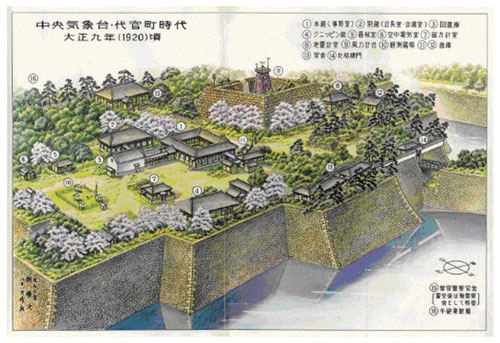
Figure 2Central Meteorological Observatory at Honmaru of Edo Castle. The building numbered 7 is for geomagnetic observation, and 6 is for atmospheric electric field observation (map supplied by the Japan Meteorological Agency).
A few officers, including Honma, engaged with geomagnetic observations at Tokyo Magnetic Observatory. Wasaburo Oishi joined the observatory in 1899 after Honma had left and installed new instruments such as Eschenhagen variometers, a Wild–Edelman magnetometer, and an Edelman earth inductor in 1911. The geomagnetic field data at Tokyo Magnetic Observatory were regularly published in the data books a few years after the observation. Recently, Toya et al. (2004) corrected obvious mistakes in the data books and made the corrected data available at KMO's homepage (http://www.kakioka-jma.go.jp/en/obsdata/tok_data.html, last access: 10 August 2022).
As Tokyo grew into a modern city in the Meiji era, geomagnetic observations in Tokyo faced an ongoing problem: city noise. A city railway network gradually emerged in the 1900s. According to Okada (1937), the observations at Honmaru by Tokyo Magnetic Observatory as well as those at Hongo by Tokyo Imperial University sometimes suffered from noise. At first, the division for city trams in Tokyo agreed with the Central Meteorological Observatory and Tokyo Imperial University to run the railway more than 500 m away from their observation sites at Honmaru and Hongo. However, a plan for a new tram near Hongo was proposed in 1912, and the Central Meteorological Observatory and Tokyo Imperial University decided to move their observation sites by using a compensation fee from the city rail.
The two institutions cooperated in the selection of the location for new observations (KMO1983; Terada, 1951; Okada, 1933). They searched for places in the vicinity of Tokyo where development of future railways was unlikely. Then, Shigehara (Chiba Prefecture) and Kakioka (Ibaraki Prefecture) were selected as the two candidates. The geological setting of Kakioka was preferred. Kakioka is about 13 km away from Ishioka Railway Station of the Joban line, situated in a small basin surrounded by the Tsukuba mountains at the margin of the Kanto Plain. The Kakioka basin consists of a marine terrace and alluvium along the Koise River. A surface sediment layer over a basalt base rock is thinner than several tens of meters in the basin, and the basalt is exposed at the Tsukuba mountains (Miyazaki et al., 1996).
Kakioka was a village of about 3000 people at the end of the Meiji era (Committee for Compilation of Yasato-cho History, 2005). The downtown developed along a highway on a hill. Rice fields, forests and small hills surround the downtown hill. Vestiges of human living in the 4th century and a medieval castle are seen today in the center of the downtown.
The Central Meteorological Observatory bought an area of 14 691 m2 at the foot of a small hill (Fuji-yama) off the Kakioka downtown with about JPY 1628 in 1912. Shortly after, Tokyo Imperial University bought a much larger area including Fuji-yama, and it surrounded the property of the Central Meteorological Observatory (Fig. 3). As KMO expanded their functions later, a part of the property of Tokyo Imperial University was given to or rented by KMO. KMO uses 72 691 m2 today, and the two properties are still next to each other. This has helped KMO because it shields KMO's observation from artificial noises.
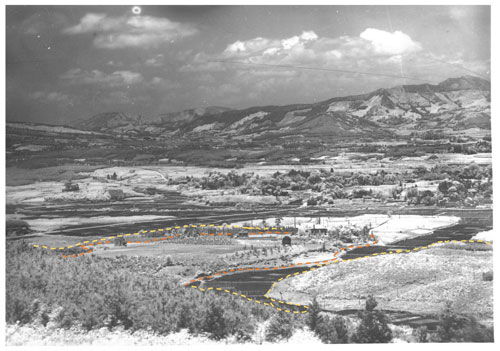
Figure 3A view of Kakioka Magnetic Observatory from Fuji-yama in 1933. An orange dotted line indicates the property of the observatory, and a yellow dotted line indicates the property of Tokyo Imperial University (after a photo supplied by Kakioka Magnetic Observatory).
The Central Meteorological Observatory built a dirt-covered stone building for continuous geomagnetic observation (known as “Ishimuro”) and two huts for the geomagnetic absolute observation and the dormitory in 1912 (Fig. 4). The Eschenhagen variometers were installed in Ishimuro, and the Wild–Edelman magnetometer was fixed in the absolute hut (Fig. 5). Then, geomagnetic observation at Kakioka was started on 1 January 1913. Weather observations were added in the next year. Thus, KMO was born here.
KMO was unstaffed at first. Oishi and other officers of the Central Meteorological Observatory visited once a month to make the absolute measurement, and a local employee occasionally replaced recording papers. All recording papers and field notes were transferred to the main office of the Central Meteorological Observatory in Tokyo, where the data were processed and published.
When the Great Kanto Earthquake hit Tokyo on 1 September 1923, it lost all data observed at Kakioka in 1911–1917 by a fire that burned the main office of the Central Meteorological Observatory down. The data before 1911 were already distributed as publications. The recording papers and instruments of Tokyo Magnetic Observatory were also burned out. The buildings of KMO were seriously damaged by the earthquake, too.
Takematsu Okada, head of the Central Meteorological Observatory at that time, decided to make KMO staffed so that the data processing, publication and storage could be done there as well as the observations (Fig. 6). He also planned to reinforce the observation and research at KMO. Weekly absolute observation was planned, and observations of the atmospheric electric field and seismicity were added to the observatory tasks. Later, observations of the geoelectric field and solar surface were started, and Okada described KMO as “practically, a comprehensive geophysical observatory” (Okada, 1933).
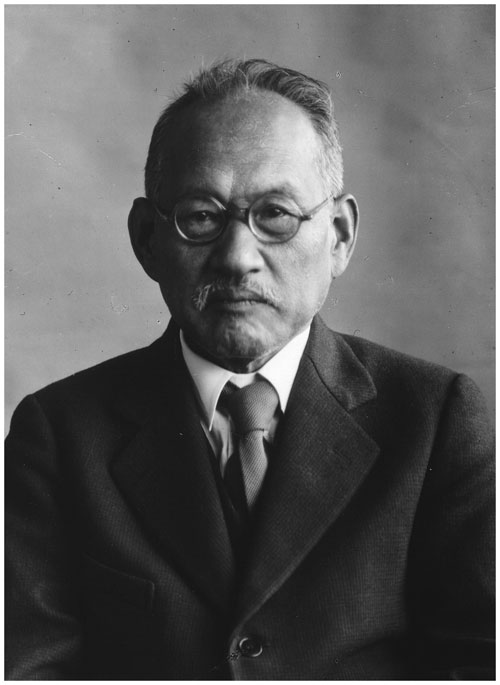
Figure 6Takematsu Okada, head of the Central Meteorological Observatory from 1923 to 1941 (photo supplied by the Japan Meteorological Agency).
Syuichi Imamichi was appointed as the first director of a new KMO in December 1923 (Fig. 7). Imamichi majored in physics at the Tokyo College of Science and was in charge of geomagnetic observation in the Central Meteorological Observatory for a while. He offered to kick off the newly born observatory himself and then devoted himself to establishing the observatory for about 28 years till he retired from KMO and took a professorship at the Tokyo College of Science in 1952.
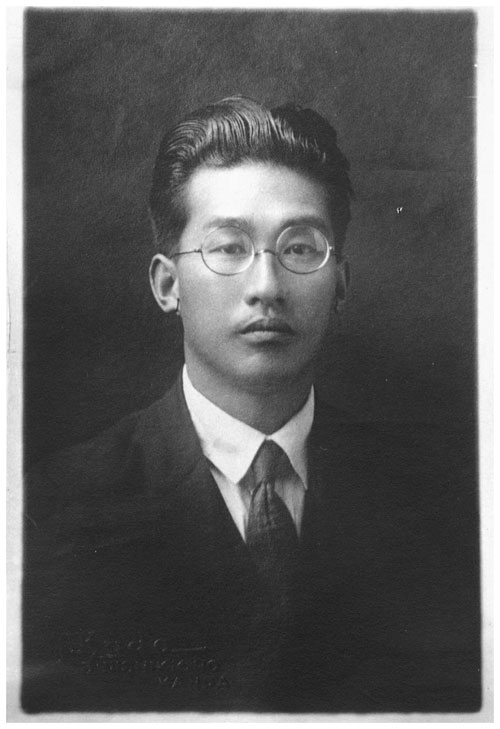
Figure 7Syuichi Imamichi, the first director of Kakioka Magnetic Observatory, in 1927. He led the observatory for about 28 years from 1923 to 1952 (photo supplied by Kakioka Magnetic Observatory).
New buildings at Kakioka were completed in 1924–1925, such as the main office, the absolute measurement hut, the geomagnetic experiment hut, the atmospheric electricity hut, and the variometer measurement hut (Fig. 8a–e), and most of them are still used today. Their designs have Spanish or German flavors and were stylish at the time. The main gate of the observatory, whose spherical stones represent the Earth, and houses for the staff were also constructed (Fig. 9a, b). Imamichi and two other officers moved to Kakioka, and geomagnetic observation was resumed in 1924 by using the same instruments as before (Fig. 9c). Later in the same year, Tanakadate reported to a business meeting at the second General Assembly of the International Union of Geophysics and Geodesy (IUGG) in Madrid that KMO would serve as the standard observatory in Japan for the time being.
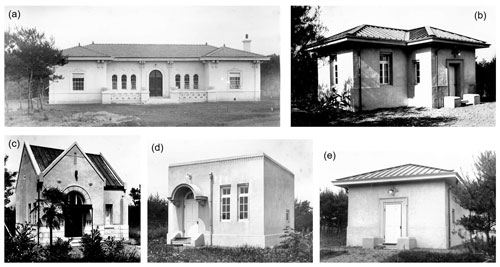
Figure 8Buildings constructed in 1924–1925. (a) The main office, (b) the absolute hut, (c) the experiment hut, (d) the atmospheric electricity hut, and (e) the variometer hut are still used today (photo supplied by Kakioka Magnetic Observatory).
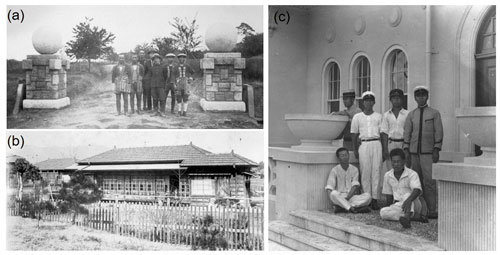
Figure 9(a) The main gate of the observatory at its completion with the craftsmen. The two spherical boulders on the top represent the Earth. (b) Houses for the staff of Kakioka Magnetic Observatory. (c) The observatory staff in August 1925. The newly staffed observatory started with three staff members in 1924, and the staff number gradually increased (photo supplied by Kakioka Magnetic Observatory).
The next task for the observatory was improvement of the precision in geomagnetic field observation. The observatory bought Eshenhagen–Schmitt variometers (Fig. 10a), an Askania–Schmitt earth inductor and a Lifler standard clock in 1924 and installed them in new buildings. Then, the old and new instruments ran simultaneously for several years. In the next year, an Indian survey pattern magnetometer (Fig. 10b) and a mobile magnetometer by Carl-Vanberg Co. were brought in. Then, a set of Schmitt theodolites (Fig. 10c) was bought for the absolute magnetometers. Imamichi went to visit Schmitt in Potsdam and Berlin, Germany, in 1927 to learn the operation of the magnetometer and to measure its calibration constants. After he came back to KMO in 1929, the Schmitt theodolite was used in the regular absolute measurements.
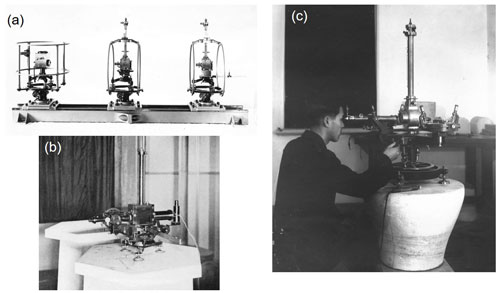
Figure 10(a) Eshenhagen–Schmitt variometers, (b) an Indian survey pattern magnetometer, and (c) a Schmitt theodolite for the declination during an observation in 1952 (photo supplied by Kakioka Magnetic Observatory).
However, the observed geomagnetic field still showed instabilities. Toya et al. (2012) rechecked field notes and recording papers from 1924 to 1946 and found some mistakes in data processing. Corrected data have not been published yet.
In 1927, Muramoto, an engineer of the Hydrographic Bureau, developed a theodolite to observe the declination, inclination and horizontal force and named it the Hydrographic Bureau theodolite (Asao, 2011). It was used for the geomagnetic survey at the Hydrographic Bureau, the army, universities and KMO (Fig. 11).
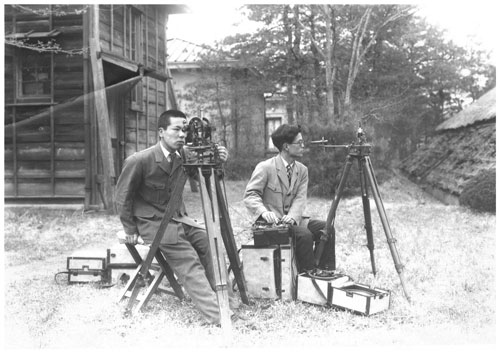
Figure 11Hydrographic Bureau theodolite for the horizontal force during an observation in 1947 at Kakioka (photo supplied by Kakioka Magnetic Observatory).
KMO had been expanding in this time period. Imamichi made efforts to hire young researchers as the staff following the way the Potsdam observatory was operated and the number of the staff reached nine in 1930 from three in 1924. New observations were started, too. A seismograph was installed by Wadachi of the Central Meteorological Observatory in 1926, which was a year before he discovered the Wadati–Benioff zone (Wadati, 1927). The observation of the atmospheric electric field commenced in 1929 with a Kelvin water dropper and a Bendorf electrometer (Fig. 12). The observation of the sunspot and solar prominence was started in 1930 with a 20 cm refractor.
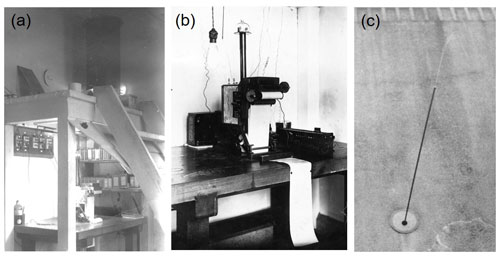
Figure 12(a) The observation system of atmospheric electric field observation in 1937. The Bendorf electrometer (b) is on a desk on a lower floor, and a black water tank of the Kelvin water dropper is next to the wall on an upper floor. A water nozzle (c) extends from the tank through a hole of the wall to the outside (photo supplied by Kakioka Magnetic Observatory).
Since the First Sino-Japanese War in 1894–1895, Japan had been on course to seek regional dominance in East Asia. Because of this circumstance, Qingdao Magnetic Observatory in China was assigned to the Central Meteorological Observatory in 1922. KMO might have helped in its operation; however, details are unknown.
The Central Meteorological Observatory took part in the Second Polar Year project (August 1932–August 1933) and added many new observations. That made KMO start geoelectric field observation in 1932 and rapid-run observation of the geomagnetic variations. Rain charge, space charge and atmospheric resistivity were also observed in 1931–1933 (Fig. 13).
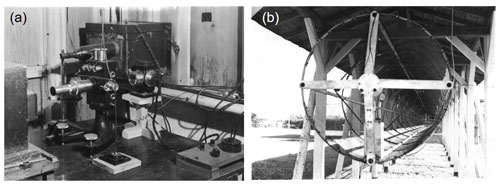
Figure 13(a) A space charge meter and (b) a collector part of the air conductivity observation system (photo supplied by Kakioka Magnetic Observatory).
Technical details of geoelectric field observation at Kakioka are summarized in Yoshimatsu (1957), KMO1983 and Nagamachi et al. (2021). Copper plates were used as electrodes, and they were installed at 3 m depth. The baseline length in both the north–south and east–west directions at the property of KMO in 1932 was 100 m (the short baseline observation) and, then, those outside the KMO property in 1933 were 1120 m in the north–south direction and 1500 m in the east–west direction (the long baseline observation). The measurement system consisted of a reflecting galvanometer and a resistor (about 10 kΩ), and a recording system consisted of photographic paper which was put on a rotating drum and light sources. The paper feed speed was 15 mm h−1 for the normal run recording. Geoelectric field observation was run in a similar manner till 1986; however, the locations of the electrodes were moved several times, and electrodes were sometimes changed to carbon rods or pods with lead wires covered with PbCl2. No photographs of the geoelectric field observation instruments in the 1930s to 1940s are available; therefore, those in the 1950s to 1980s are shown in Fig. 14.
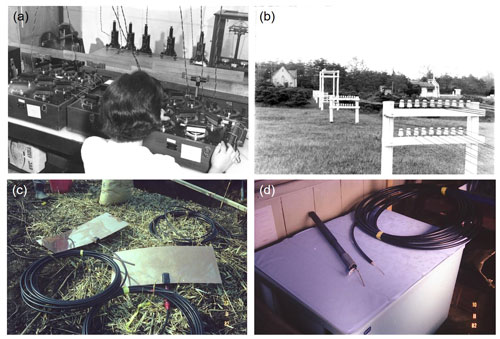
Figure 14(a) A reflecting galvanometer and a voltmeter with a 10 kΩ resistor, (b) cables, (c) a pair of copper plate electrodes and (d) a carbon rod electrode (photo supplied by Kakioka Magnetic Observatory).
Then, KMO opened a new magnetic observatory in Yuzhno-Sakhalinsk in Russia in 1932 associated with the Second Polar Year project. This observatory was first named Toyohara Temporal Magnetic Observatory and is a predecessor of Yuzhno-Sakhalinsk Magnetic Observatory (Fig. 15). The geomagnetic and geoelectric fields were continuously observed at Toyohara from 1932 to 1940, and some of those data were published (Central Meteorological Observatory, 1936). The observatory was moved in 1941, and it was renamed Toyohara Magnetic Observatory. The geomagnetic and geoelectric data at the new place have remained unpublished, although copies of some data are stored at KMO.
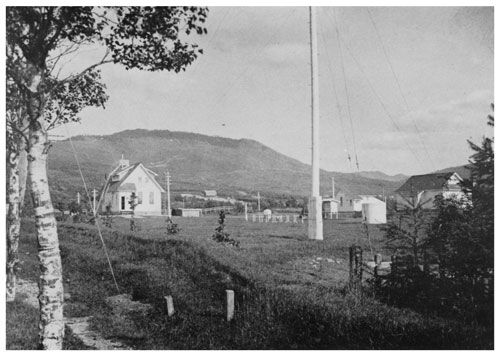
Figure 15Toyohara Magnetic Observatory (later known as Yuzhno-Sakhalinsk Magnetic Observatory) (photo supplied by Kakioka Magnetic Observatory).
In order to support those activities, the number of staff was gradually increased from 10 in 1932 to 21 in 1941.
The activities for the Second Polar Year project boosted scientific research at KMO as well as at universities in Japan. For instance, Misao Hirayama, the second and last director of Toyohara Magnetic Observatory, published one of the very first theoretical works on magnetotellurics, namely, electromagnetic induction inside the Earth (Hirayama, 1934). Hisanao Hatakeyama, the first director of Toyohara Temporal Magnetic Observatory and later a head of the Central Meteorological Observatory, published his prize-winning paper on the bay and pulsation of the geomagnetic field (Hatakeyama, 1938a, b, c). Imamichi revealed that the sudden commencement has a travelling nature by using the geomagnetic fields at Kakioka, Yuzhno-Sakhalinsk and Qingdao (Imamichi, 1938b). Other studies can be seen in many journals, for instance Memoirs of the Kakioka Magnetic Observatory, which was established in 1936 (http://www.kakioka-jma.go.jp/publ/journal_DB/index_e.php?no=1&, last access: 10 August 2022).
The momentum to promote research activities still continued for a while after the Second Polar Year. Several projects such as the geomagnetic survey in Japan and surrounding areas, the geomagnetic and geoelectric variations under eclipses, and lightning observations started; however, some gradually faded because of a series of wars (the Second Sino-Japanese War in 1937–1945 and the Pacific War in 1941–1945). Then, studies sponsored by military forces were increased. Under these circumstances, Imamichi and Tadao Kuboki at KMO kept working on developing new measurement methods to observe geomagnetic field variations at high frequencies. A Nagaoka-type variometer, XY loop coils (Imamichi, 1954) and a KC-type variometer (Kuboki, 1951b) were introduced or developed at Kakioka in the 1940s.
Research achievements in Japan of the 1940s can be seen in Society of Geoelectromagnetism of Japan (1951), where a variety of studies conducted at KMO, such as magnetic pulsations (KMO1983), the Dellinger effect (Imamichi, 1943), magnetic field surveys in Japan (Yumura, 1942), atmospheric electric potential gradients (Hirayama, 1944), electric field variations due to earthquakes (Yoshimatsu, 1943), and light of the night sky (Utsumi, 1943), were reviewed. That suggests that KMO became a leading research institution in Japan.
In the 1940s, essential supplies for living gradually disappeared in shops. Bombing over the Japanese islands often happened, but, fortunately enough, direct attacks to Kakioka were rare. Many male staff of KMO had to leave the observatory to be conscripted into the army. According to KMO1983, the staff shortage affected even the operation of the regular observations at KMO, although the number of technical staff quickly increased up to 57 in 1945. The publication of the data was stopped in 1941. The regular observations were continued mostly by female technical staff members who were mostly hired in the 1940s and reached 33 % of all staff excluding part-timers in 1945 (Fig. 16).
When the Pacific War was over in 1945, Japanese society faced drastic changes and experienced confusion. New systems of the society were brought in during those days, and many of them are still in use in the present day. For instance, the Constitution of Japan was established in 1947, being transformed from the Constitution of the Empire of Japan.
Concerning KMO, integration of the three national institutions for the regular geomagnetic field observation in Japan (KMO, Hydrographic Bureau, and Geographical Survey Institute) was discussed. Eventually, it was decided to leave it unchanged. KMO had to manage to keep the observations going by themselves.
Imamichi then led KMO after 1945. The staff number reached 61 in 1947 because some were back from the army or Toyohara. It was reduced to 49 in 1950 following a government policy and the number of the female staff was gradually decreased. Imamichi needed to organize those people and to operate KMO as a national standard observatory and research institute.
Two problems that KMO confronted as the standard observatory of the nation were a reconstruction of their monitoring network of the regional geomagnetic field and an update of their monitoring instruments.
The observatory at Kakioka was the only working one for KMO in 1945 since Toyohara Magnetic Observatory was transferred to the Soviet Union. On the other hand, geoelectric field observation was promoted in a new action plan of the Central Meteorological Observatory in order to predict earthquakes (Central Meteorological Observatory, 1945). Therefore, KMO opened five new observatories in 1946 at Ikutora, Morioka, Haranomachi, Owashi, and Miyakonojyo (Fig. 1) and started geoelectric field observations there. After checking the quality of observed data, Ikutora and Miyakonojyo observatories were moved to Memambetsu (MMB) in 1949 and Kanoya (KNY) in 1948, respectively (Fig. 1). The MMB property is used to be a base for a meteorological troop of the navy, while the KNY one was a private property provided free. Although Morioka and Owashi observatories were closed in 1951, the tentative geoelectric observatories at MMB and KNY were transformed into regular geomagnetic observatories in the 1950s (Fig. 17). For MMB, the regular observations of the geoelectric field and the atmospheric electric field were started in 1950 with eight staff members, and geomagnetic field observation was added in 1952. Regular geoelectric field observation at KNY was started in 1949 with two staff members, and geomagnetic field observation commenced in 1958. After Haranomachi Observatory was closed in 1957, its staff members there were transferred to KNY.

Figure 17(a) The absolute measurement house of Memambetsu Magnetic Observatory in 1952. (b) The main office at Kanoya Magnetic Observatory in 1969 (photo supplied by Kakioka Magnetic Observatory).
A project to develop new instruments for geomagnetic field observation kicked off in the 1950s in order to solve a long-standing problem in the observation accuracy. The fact that KMO was chosen to serve as the national institution to authorize magnetometers in 1952 was a boost too.
Development of a new magnetic theodolite for the absolute measurement at Kakioka was promoted under the cooperation with the Science Council of Japan and universities from 1952. According to Yoshimatsu (1958), the newly designed theodolite contained a Helmholtz coil and a search coil in it and resolved 0.5 nT or 3 s, which was a high standard at that time. The main theodolite, named A-56, was for the H, Z, D and I components and another supporting one, H-56, for the H component (Fig. 18). Making of A-56 and H-56 required the cooperation of many factories in Japan, and they took 4 years to complete. KMO rented a part of the property of the University of Tokyo (formerly Tokyo Imperial University) and built a new hut for A-56 and H-56 there. Those theodolites started to work in 1958.

Figure 18New theodolites developed by Kakioka Magnetic Observatory. (a) A-56 for the horizontal force, the vertical component, the declination and the inclination, (b) H-56 for the horizontal force, and (c) the absolute measurement room with A-56, H-56, and attached equipment such as collimators and a voltmeter (photo supplied by Kakioka Magnetic Observatory).
At the same time, development of a new variometer was also initiated. Based on several experiences with variometers in the 1940s, the new variometers were designed and manufactured at KMO (Fig. 19). They used a suspended magnet that was fixed with threads of quartz and phosphor bronze. A newly developed magnetic shunt alloy (Kuboki, 1951a, 1976) was mounted on the magnet to compensate for the temperature effect. The first prototypes of the new variometer KM type for the H and D components and KZ type for the Z component were made in 1947, and installation of the final version at Kakioka (KAK), KNY and MMB was completed in 1957 (Fig. 20). The KM- and KZ-type variometers stabilized the geomagnetic variation observation, and the data accuracy of the geomagnetic variation met that of the absolute measurement made by A-56 and H-56 (Yanagihara, 1975).
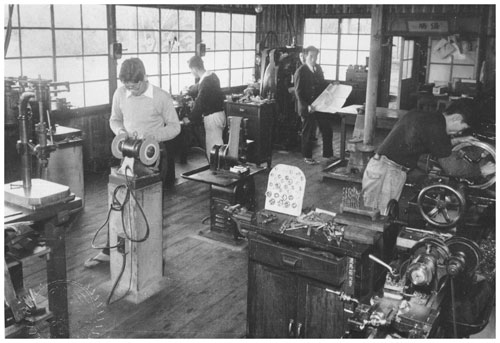
Figure 19The craft room at Kakioka Magnetic Observatory (photo supplied by Kakioka Magnetic Observatory).
KMO also prompted other observations such as the electric conductivity of the soil by the electric exploration, the ion number in the air in this time period. In addition, K index at KAK was first published in 1951. Publication of the yearbook resumed also in 1951.
Achievements by KMO during this post war time were highly valued among the academics in Japan. KMO was honoured to host the third meeting of the Society of Geoelectromagnetism of Japan at Kakioka in 1948. The society was founded in 1947 and the first and second meetings were held at the University of Tokyo (formerly Tokyo Imperial University) and Kyoto University, respectively. During the meeting at Kakioka, 40 oral presentations were given and Tanakadate's last visit to Kakioka was realized (Fig. 21). Ota (1983) recalled that visiting researchers were warmly welcomed by the KMO staff and the villagers and they appreciated that three meals were provided every day because people in city were suffering from food shortages. KMO also hosted the meeting of the Society of Geoelectromagnetism of Japan in 1952, 1957 and 1962 at Kakioka. Four staff members in total joined the board of councillors for the society till 1976.
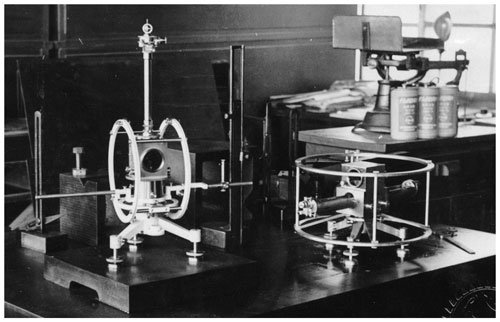
Figure 20New variometers designed and manufactured by Kakioka Magnetic Observatory. The (left) KM-type variometer for the horizontal force and the declination and (right) the KZ-type variometer for the vertical component (photo supplied by Kakioka Magnetic Observatory).
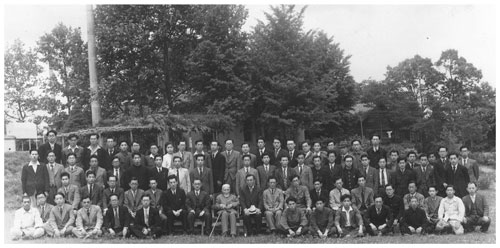
Figure 21Attendants of the third meeting of the Society of Geoelectromagnetism of Japan which was held at Kakioka in 1948. Tanakadate is on a chair with a stick in the front row (photo supplied by Kakioka Magnetic Observatory).
After those efforts to reorganize KMO in the post-war confusion, Imamichi retired at the age limit in 1952. Takasaburo Yoshimatsu succeeded him. After his retirement from KMO, Imamichi worked on geomagnetism at the Tokyo Science College and the University of Tehran.
Another big topic in the 1950s was train noise at Kakioka. When an Ibaraki section of the Joban train line (a section between Toride and Hirama) was considered to be equipped as a direct-current line to transport large loads to Tokyo, a concern arose whether that would cause a noise in geomagnetic observation at Kakioka as most of the section was located within 30 km of Kakioka.
The Ministry of Transport formed a technical committee to research the noise in 1951, and a test observation of the train noise near a direct-current section was conducted. Then, the ministry organized a meeting to discuss the problem in 1953 among representatives of Ministry of Transport, Japanese National Railways, universities and the Central Meteorological Observatory. The acceptable noise level for KMO was set at 0.3 nT at Kakioka and observational and theoretical studies indicated that this criterion would be met if the section within 30 km from Kakioka was powered by the alternating current. The committee recommended Japanese National Railways to build the Toride-Mito section as an alternative current line (KMO1983).
Thus, the Ibaraki section of the Joban line was powered by the alternating current; the power system was changed between Toride and Fujishiro. The noise at Kakioka was observed and was proven to be less than 0.3 nT (Yanagihara, 1977).
A further important step on this issue was taken later. The government and the Ministry of Industry regulated in 1964 and 1965 that commercial electric infrastructure cannot affect geoelectric and geomagnetic field observations by national institutions such as KMO, the Geographical Survey Institute, the Marine Guard, and the National Astronomical Observatory. These unique laws are one of the reasons why the geoelectric and geomagnetic observations at Kakioka have survived for more than 100 years nearby Tokyo, which has been a world megacity. However, the protection of KMO keeps causing a strain between KMO and locals, because it is said that it has discouraged more frequent railway services to Tokyo in the alternating current section of the Joban line, resulting in weaker urbanization of the area around Kakioka.
The Japanese experienced a quick recovery from the devastation of the wars in the 1950s, and their economy was especially boosted in 1955–1973. The national budget for science and technology was quickly increased in the late 1950s (Kurosawa et al., 1967). The Central Meteorological Observatory was promoted to the Japan Meteorological Agency (JMA) in 1956. As for the Earth and space sciences, a project on rockets was started for the first time in Japan at the Institute of Industrial Science, the University of Tokyo in 1955. The budget for space science and technology has increased since. The Earthquake Prediction Research Group (1962) published the “blueprint”, and it recommended the promotion of KMO's geomagnetic and geoelectric field observations for the prediction study. Then, the First National Earthquake Prediction Programs started in 1965 based on the blueprint. The program was verified every 5 years and continued until 1998.
At the same time, a series of international activities on geophysics were conducted, for instance, International Geophysical Year (IGY, 1958–1959), International Geophysical Cooperation (IGC, 1959–1963), International Quiet Sun Years (IQSY, 1964–1965), Upper Mantle Project (1964–1966), International Active Sun Years (IASY, 1969–1971), Monitoring of the Sun-Earth Environment (MONSEE, 1972–) and International Magnetospheric Study (1976–1979).
KMO participated in those activities, and two big changes were brought to observations at KMO in the 1950s to 1960s: improvement of the high-speed sampling observation and introduction of new technologies.
Observations of high-frequency phenomena were demanded in studies of solar–terrestrial space physics. The rotation rate of a recording paper was increased, and new censors and recording units were developed (e.g., Kuboki, 1951b; Kawamura and Kashiwabara, 1965). Rapid-run observations of the geomagnetic and geoelectric fields were started in 1957 at KAK and MMB and in 1958 at KNY. Ultra rapid-run observations were conducted to observe Pc1 at MMB and KNY in 1964–1966, while the ELF observation was introduced at Kakioka in the mid-1960s. Then, the ELF and ULF observations were conducted at KAK, KNY and MMB in the IASY period.
New technologies to observe the geomagnetic field were introduced in this time period. A fluxgate magnetometer was used for the first time to observe the geomagnetic field variation aiming at detection of conductivity anomalies in Fukushima in 1964–1965. Then, a long-term observation of the geomagnetic field variation was set at Iwaki (Fig. 1) in 1967 as a part of the First National Earthquake Prediction Program. At the same time, KMO developed a new theodolite, MO-P, which consisted of a proton precession magnetometer with two Helmholz coils around it in order to measure the horizontal force and vertical components of the geomagnetic field in the absolute measurement in 1963 (Fig. 22). Then, the proton precession magnetometers were added to KAK, KNY and MMB in 1967–1969 to observe secular variations of the geomagnetic total force as a part of the First National Earthquake Prediction Program, and then they were used for the absolute measurement too. The proton precession magnetometer at KAK was transferred to Kitaura in 1982 (Fig. 1).
Atmospheric electric field observation was also updated along with those international activities, giving the electrical conductivity observation and the atmospheric electric current observation being added.
Other observations such as the whole sky photography and the geomagnetic vector variation were undertaken in this time period. The first photographs of the aurora in Japan were taken on 11 February 1958 at MMB during the aurora observation with a whole-sky camera in a cooperative work with Tokyo Astronomical Observatory. These photographs were reanalyzed recently to reveal a fan shape of the aurora (Kataoka et al., 2019).
KMO established another geomagnetic observatory at Chichijima (CBI, Fig. 1) on an isolated island of the Izu-Bonin arc in 1971 (Fig. 23). CBI has been unstaffed since the beginning. The geomagnetic field variation has been continuously observed, and the absolute measurement has been done by the staff at KAK every few months.
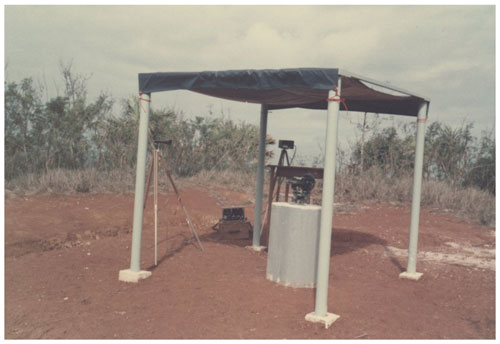
Figure 23The pillar for the absolute measurement at Chichijima Magnetic Observatory (photo supplied by Kakioka Magnetic Observatory).
KMO launched a new journal in 1961, Gijyutu Houkoku, which means “technical report” in English. Observation and research activity at KMO at that time can be seen in Gijyutu Houkoku as well as Memoir of Kakioka Magnetic Observatory. Unfortunately, Gijyutu Houkoku is only available offline.
KMO initiated the biggest project in its history in the late 1960s. Both a theodolite for the absolute measurement and a variometer for the continuous measurement had to be updated. A committee was formed in 1968 for a feasibility study to develop a new standard magnetometer system. The team for this project at KMO was led by Kazuo Yanagihara, who had worked for KMO since 1947 after he had studied physics at the University of Tokyo, and he served as the fourth director of KMO from 1969 to 1976. Many staff members pointed out that his vision and enthusiasm had driven the project forward (e.g., Kuwashima, 2012; Kawamura, 2013). Yanagihara was open-minded to using a new technology and was determined to exclude as many noise sources as possible. He recalled his visit to Castlerock Magnetic Observatory in California to see an observation system using brand-new optical pumping magnetometers (Yanagihara, 1983).
The committee finalized an extremely ambitious plan in 1969. In their plan, the geomagnetic field was measured at the highest standard in the world in a digital form by using four optical pumping magnetometers, a newly designed theodolite, a proton precession magnetometer and a computing unit. Not only the accuracy of measured values but also a fine time resolution was ambitious; they planned to measure the geomagnetic field every 3 s and provide 1 min values averaging 3 s values on a regular basis. Furthermore, the continuous measurement including data processing was automatically controlled. Buildings were also planned to be newly constructed to reduce observation noises. The whole observation system was named KASMMER.
Thus, the JPY 200 million project to construct the observation system of the geomagnetic field to the highest standards kicked off in 1970. The new theodolite, named DI-72, consisted of a Helmholtz coil for a rough compensation and a search coil for a fine compensation and measured both the declination and inclination simultaneously by manually rotating the coils with a resolution of 1 arcsec. A proton precession magnetometer and DI-72 formed an apparatus for the absolute measurement (Fig. 24).
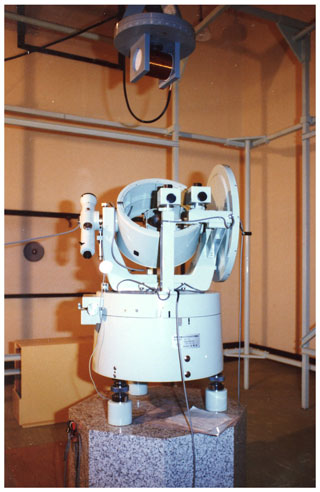
Figure 24Newly developed theodolite DI-72 beneath a proton processor magnetometer (photo supplied by Kakioka Magnetic Observatory).
The continuous measurements were done by three optical pumping magnetometers with Helmholtz coils around them for three vector components and one optical pumping magnetometer for the total force (Fig. 25). The magnetometers measured the geomagnetic field every 3 s with a resolution of 0.1 nT.
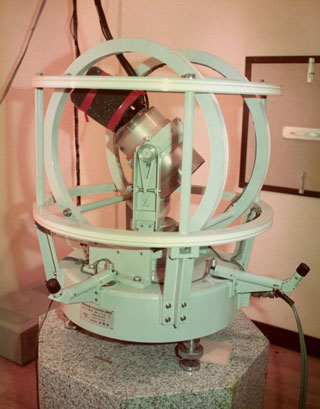
Figure 25Optical pumping magnetometer with a set of Helmholtz coils surrounding it (photo supplied by Kakioka Magnetic Observatory).
Those magnetometers were connected to the computing unit away from the observation area. The computing unit consisted of two HITAC-6 computers, a storage, a magnetic tape recorder, typewriters and so on (Fig. 26). Observed data by the optical pumping magnetometers were transferred to the computer in real time, and the data of the absolute measurement were manually uploaded. Those data were automatically and manually processed.
The area of about 13 000 m2 at the southern end of the KMO property was levelled to construct several huts for the new magnetometers (Fig. 27a). They had to be nonmagnetic and be separated from each other so that magnetometers in the huts would not interfere each other. The DI-72 and proton precession magnetometer were installed in the biggest hut which was air-conditioned and in raised-floor style in order to reduce the effect of the crustal magnetization. Two observation pillars were 3.6 m-tall granite rocks brought from Inada, north of Mt. Tsukuba, and were mostly buried in the ground for stability (Fig. 27b). On the other hand, each optical pumping magnetometer occupied a small hut north of the absolute measurement hut. These small huts had lower floors compared to the absolute measurement hut and observation pillars were just placed on the base not to disturb the crustal magnetization.

Figure 27Huts where KASMMER instruments are installed. (a) The biggest hut is for DI-72, and four small huts are for optical pumping magnetometers. (b) Two 3.6 m pillars for theodolites were installed in the process of constructing the biggest hut (a: photo taken by Ikuko Fujii and b: photo supplied by Kakioka Magnetic Observatory).
KASMMER was completed in 1972 and succeeded the old system in 1973 making 1 min values of the geomagnetic field at KAK available. KASMMER's specifications and test results were presented by Yanagihara et al. (1973). They claimed that the continuous observation and the theodolite observation had accuracies of 0.1 nT and 1 min, respectively. Thus, geomagnetic field observation at KMO reached the highest level.
The absolute observation system at MMB was updated in 1975 following the success of KASMMER (Mizuno et al., 1987). A theodolite, DI-75, which is similar to DI-72, and a vector proton precession magnetometer, MOP-75, which consisted of a proton precession magnetometer with two Helmholz coils, were introduced. MOP-75 was able to measure the H, Z and F components of the geomagnetic field with an accuracy of 0.2 nT. At the same time, the sensor of atmospheric electric field observation at MMB was changed from a radioactive collector to a field mill.
The Nixon shock in 1971 and the oil shock in 1973 caused economic recessions in Japan before the economy recovered and started booming again. KMO suffered from staff cuts and obtained no megaprojects; however, KMO launched several services and projects in this period by using the data and technologies acquired through the KASMMER project.
The World Data Centre for Geomagnetism, Kyoto, started to publish the Dst index in 1986 by using the geomagnetic field at Kakioka as well as a few other observatories in the world. The geomagnetic field at MMB was included to compute the Kn index in 1968, while that at KNY was used to detect sudden commencements of magnetic storms in 1975 (e.g., Mayaud, 1980).
KMO proceeded for a service of high-speed sampling values in the 1980s. The computing unit of KASMMER was updated from HITAC-10 to HAITAC E-600 in 1981. That enabled KMO to store 3 s digital values of the geomagnetic field at KAK in 1980 and then 1 s digital values in 1983 resulting that 1 min values were averaged values not instant values. Observation systems of the geomagnetic field were updated in 1979 at MMB, in 1980 at KNY and in 1989 at CBI to make the 1 min value averaged. Then, updates of recording systems for the geoelectric field were followed at KAK, KNY, and MMB and the 1 min value of the geoelectric field was published at KAK, KNY and MMB in 1987. Thus, an unprecedented data set of the geomagnetic and geoelectric fields with the high sampling rate at KAK, KNY and MMB was made available in the 1980s.
Research activity had been promoted in KMO in this period. For instance, total force observation at volcanoes commenced in the 1970s, aiming to study geomagnetic variations caused by volcanic activity. Based on the proposal by the Science Council of Japan, the KNY staff started the repeat observation at Sakurajima and Aso volcanoes in 1977–1978. Then, the KAK staff started the repeat observation at Kusatsu-Shirane volcano in 1976 and the MMB staff started the repeat observation at Meakandake volcano in 1977. The observations at Aso, Kusatsu-Shirane and Meakandake volcanoes have been expanded and are still ongoing at present, giving unique data sets to indicate long-term trends of thermal activity in volcanoes (e.g., Takahashi and Fujii, 2014; Takahashi et al, 2018).
KMO conducted many cooperative research projects with universities and research institutions. For instance, the three vector components and total force of the geomagnetic field and the two horizontal components of the geoelectric field were observed at Omaezaki and Matuzaki in the Tokai region aiming at the earthquake prediction in 1979, and geophysical exploration was added in 1982.
Participation in the Japanese Antarctica Research Expedition started in 1968. Goro Kondo observed the atmospheric electric field in Antarctica as well as the geomagnetic field as a member of the 10th Japanese Antarctica Research Expedition (Kondo, 1971). Since then, the KMO staff has joined the expedition every few years for geomagnetic field observation and conducted studies on, e.g., the atmospheric electric field, aurora, or night sky as well.
Under the booming economy, many villages and towns had been urbanized or suburbanized in Japan, causing friction between neighbors and KMO. The noise level at KNY became worse in the late 1970s and that is an ongoing problem at present. KMO built a reference observation point, Haraigawa, 2 km away from KNY in 1988 in order to compare the geomagnetic field variations at the two sites (Sakai et al., 1989). The long baseline observation of the geoelectric field was terminated in 1988 at KAK, because the growing population of Kakioka made KMO difficult to keep a large-scale observation system outside the KMO property.
However, the biggest conflict happened at the beginning of the 1980s. The observation at KAK faced a local request to move in order to reinforce the railway service to Tokyo. Conferences were held in 1982–1983 by the local government of Ibaraki Prefecture, the Ministry of Transport, Japanese National Railways, academics and the JMA to consider the possibility that observations at KAK be moved away from the Joban railway line. At the same time, the JMA formed a committee to discuss necessary duties of KMO, and the Society of Terrestrial Magnetism and Geoelectricity of Japan examined possible influences of the move. The move was not realized in the end because the estimated cost of the KAK move was too expensive for any organization to afford. However, it was concluded that the KAK move itself was scientifically possible (Ibaraki Prefecture, 1983, 1986).
After those good and bad times, KMO celebrated the centennial anniversary of geomagnetic field observation in Japan and the 70th anniversary of geomagnetic field observation at Kakioka in 1983 (Kawamura, 2013). The book “Centennial history of geomagnetic observations in Japan” (KMO1983) was published by KMO and the ceremony was held at Kakioka in March 1983 (Fig. 28).
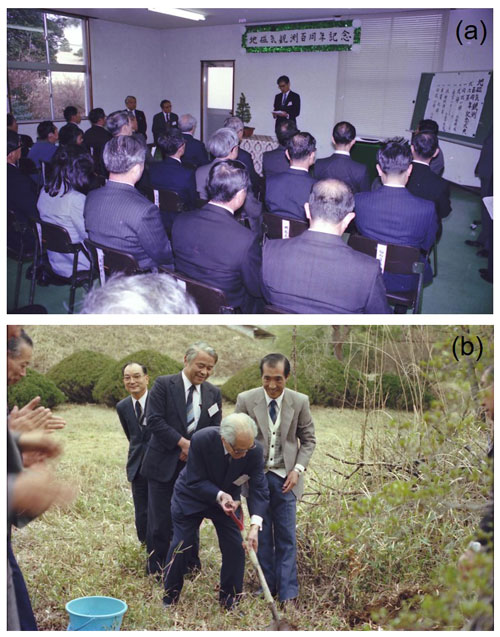
Figure 28The ceremony of the centennial anniversary of geomagnetic field observation in Japan and the 70th anniversary of geomagnetic field observation at Kakioka held in March 1983. (a) A speech by Masuzawa, director general of the Japan Meteorological Agency, and (b) memorial tree planting by Imamichi, the first director of Kakioka Magnetic Observatory (photo supplied by Kakioka Magnetic Observatory).
KMO has been an institute of the JMA since its foundation; however, the JMA (the former Central Meteorological Observatory) was transferred from several ministries, and the JMA's object was changed depending on the ministry to which it belonged.
The Central Meteorological Observatory was founded by the Ministry of the Interior in 1875 and then was placed under the Ministry of Education from 1895 to 1942. It was transferred to the Ministry of Transport in 1943 (Japan Meteorological Agency, 1975). The Ministry of Transport was reformed to the Ministry of Land, Infrastructure and Transport in 2001. Since the Ministry of Education was in charge of administration related to scientific research, the Central Meteorological Observatory was active in studies as well as weather forecasting services. Under the Ministry of Transport, the Central Meteorological Observatory (JMA after 1956) gradually gave priority to service to the public (Wakabayashi, 2019). Based on the Meteorological Service Act enacted in 1956, the JMA had been establishing their administrative system since the 1950s and had been expanding or elaborating their services such that they started numerical weather predictions in 1959, launched a nowcast service in 1988 and founded the seismology and volcanology department in 1984 to monitor seismic activity in Japan more intensively. By the 1980s the JMA had grown into a huge organization with more than 6000 employees and conducted observations, analysis and forecasting/warning services of climate, oceanography, seismology, volcanology, etc. Most of the JMA's observatories and institutes had no duties related to electromagnetism.
The Japanese government started to reform the administration system at the beginning of the 1980s for fiscal reconstruction (e.g., Second Provisional Commission for Administrative Reform, 1983). As part of that action, the JMA made several significant changes in its administration in the 1980s to 1990s, and basically this system has been working since. For instance, the JMA defined KMO as an auxiliary organ in 1984 together with the Meteorological Research Institute, Meteorological Satellite Centre, Aerological Observatory, Matsushiro Seismological Observatory, and Meteorological College. In addition, human resource planning was centralized, so that the director of KMO and new employees are basically appointed by the headquarters in Tokyo. As JMA employees usually move to other positions every few years, KMO has been involved in this system as one of the JMA's institutions.
The JMA's transformation influenced KMO in various ways. For instance, KMO had five directors (excluding two substitutes during the absence of Imamichi, the first director) for 60 years from 1923 to 1983, while they have had 19 directors in the 38 years since Makoto Kawamura, the fifth director, left KMO in April 1983. Many directors after 1983 had never worked for KMO before they became the directors nor experienced works related to geoelectromagnetism. At the same time, majority of division heads of KMO have been new to the KMO works. Before 1983, directors and division heads were often selected among the KMO staff who experienced works of KMO for many years and did studies on geoelectromagnetism. Basically, the nature of the leadership changed in 1983.
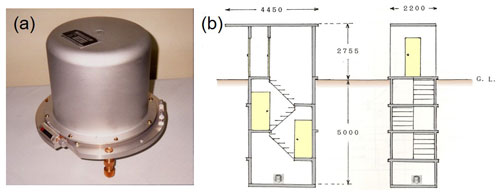
Figure 29(a) FM90, the fluxgate magnetometer with level meters. (b) Cross sections of the observation hut which was constructed for the fluxgate magnetometer. The fluxgate magnetometer is installed at a depth of 5 m (photo and document supplied by Kakioka Magnetic Observatory).
On the other hand, in the 1970s, the JMA examined possibilities to centralize the research activity into the Meteorological Research Institute so that the other auxiliary organs including KMO could focus on observations and public services. No drastic changes happened in the end, and those auxiliary organs keep their research duties at present. However, several changes have been introduced to restrict research activities there. For instance, only researchers of the Meteorological Research Institute qualify to apply for Grants-in-Aid for Scientific Research by Japan Society for the Promotion of Science which is one of the biggest research grants in Japan. Researchers of the other auxiliary organs could apply for some other grants, but opportunities were gradually shrunk.
KMO obtained a research grant from Funds for integrated promotion of social-system reform and research and development to run the observations of the geomagnetic and geoelectric fields in the Tokai region in 1979 and maintained the observation until 1996. Then, since 1996, KMO has run a 5-year JMA project to observe the geoelectric field with long baselines in Awaji-shima island in order to investigate seismo-geoelectric signals originating from aftershocks of the Great Hanshin-Awaji Earthquake in 1995 (Kakioka Magnetic Observatory, 2002). After that, KMO has joined several research projects and played supporting roles. For instance, KMO cooperated with the Earthquake Research Institute, the University of Tokyo in Ocean Hemisphere Network Project from 1996 to help the construction of an absolute measurement point of the geomagnetic field in Christmas Island in 1997 and to conduct the absolute measurements of the geomagnetic field at Ponape, Marcus, etc.
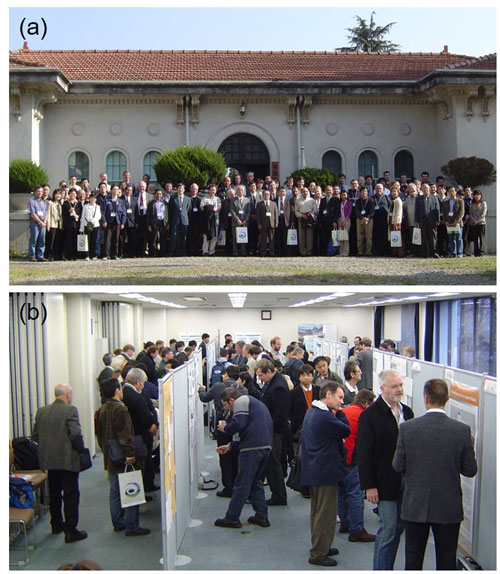
Figure 30The 11th IAGA Workshop on Geomagnetic Observatory Instruments, Data Acquisition and Processing held on 9–17 November 2004. The measurement session was held at Kakioka (a), while the scientific session was held at Tsukuba (b) (photo supplied by Kakioka Magnetic Observatory).
Under increasing pressure to enhance public services and narrow research opportunities, research staff gradually left KMO in the 1980s to 1990s, while skilled technical staff tended to stay at KMO because the skills of the geoelectromagnetic observations were not used at other JMA institutes. Thus, the personal tradition that employed young academics and grew them to leaders, which Imamichi, the first director, introduced, finished playing a role by the end of the 20th century.
Under such a changing circumstance, KMO kept updating their observations through the 1980s to 1990s, and technologies introduced in this time still work there. The observation system for the geomagnetic field variation was updated at KAK in 1989–1992. The fluxgate magnetometer was introduced in 1989 for higher-frequency observations, and four optical pumping magnetometers were replaced with four Overhauser magnetometers in 1990–1992 serving as substitutes (Tsunomura et al., 1994). The fluxgate magnetometer was installed in an air-conditioned room at 5 m depth in order to keep the air temperature as constant as possible (Fig. 29). Then, a level meter was attached in 1997 to monitor ground movements due to earthquakes and so on (Shigeno et al., 1999). The 1 s values of the geomagnetic field variation at KAK observed by the fluxgate magnetometer began to be published in 1993, and then the 0.1 s values began to be published in 1997. Fluxgate magnetometers were installed at KNY in 1995 and at MMB in 1996 (Owada et al., 1998). The absolute measurement at KNY was also updated in 1995 as a new absolute hut was built and a DI-Flux magnetometer was introduced following using a DI-Flux magnetometer for the absolute measurement at MMB in 1992.
KMO also updated their geoelectric field observations to make them with high sampling rates. The 0.1 s values of the geoelectric field were made available at 1996–1997 at KAK, MMB and KNY, and the 1 s values were made public in 2000–2001. Mori (1985, 1987) developed a new method to measure geoelectric potential differences over long distances with telephone cables, and later those works led to a nationwide research project, Network MT (e.g., Uyeshima et al., 2001).
Internationally, KAK became a member observatory of International Real-time Magnetic Observatory Network (INTERMAGNET) in 1992 and MMB followed next year. Participation of KNY was delayed till 2002.
Circumstances around KMO have been tough in the 21st century. It has been facing the continuous pressure of a small budget, and there have been very limited opportunities to hire people who major in geoelectromagnetism. However, KMO has been searching for a way to fit with the times.
KMO reformed a way of public communication and deliverable publication at the beginning of the 2000s. It established the Observatory News in 2002. Two journals, Memoirs of the Kakioka Magnetic Observatory and Gijyutsu houkoku, were integrated into the Technical Report of the Kakioka Magnetic Observatory in 2003 (http://www.kakioka-jma.go.jp/publ/journal_DB/index_e.php?no=3&, last access: 10 August 2022). The CD-ROM yearbook with original plotting software was published for the first time in 2003.
KMO hosted the 11th IAGA Workshop on Geomagnetic Observatory Instruments, Data Acquisition and Processing on 9–17 November 2004 (Okada et al., 2005). The measurement session was held at Kakioka, and the scientific session was held at Tsukuba, a nearby city where the Meteorological Research Institute of the JMA is situated (Fig. 30); 147 participants came from 32 countries.

Figure 31A special session, “100 years of geomagnetic observations at Kakioka – contributions to centennial progress of geophysics”, at the annual meeting of the Japan Geoscience Union on 24 May at Makuhari, Chiba (photo supplied by Kakioka Magnetic Observatory).
As the JMA proceeded with a plan of reduction of its workforce, KMO had to reorganize its observations after the workshop. At first KMO made an investment in its equipment. The artificial geomagnetic disturbances monitoring system was developed in 2007 to detect and estimate noises caused by magnetic bodies like cars near the property of the observatory (Minamoto et al., 2011; Nagamachi et al., 2013). The system consists of magnetometers and web cameras and can be operated remotely. In 2010–2011, fluxgate magnetometers at KAK, MMB, and KNY were replaced with high-sensitivity ones (Yamazaki and Mishima, 2013), and data acquisition systems of the geomagnetic field and geoelectric field at KAK, MMB, and KNY were updated so that the 0.1 s values of both the fields were free from system filters. After those preparations, KMO unstaffed MMB and KNY in April 2011. The observation of the atmospheric electric field at MMB was terminated when the observatory was unstaffed. Most of the MMB and KNY staff moved to KAK and one staff member for each MMB and KNY works for the closest meteorological observatory in order to conduct the absolute measurement once every 2 weeks.
As the final process of unmanning MMB and KNY was going on, KAK was struck by an unexpected disaster. The 2011 Tohoku Earthquake on 11 March 2011 damaged some buildings and instruments at KAK, which is more than 200 km southwest of the epicenter area. The area around KAK suffered from failures of electric power and water supply and the kerosene and petrol were sold out in a series of aftershocks. The KAK staff struggled to keep their magnetic and electric observations going in the confusion. The emergency power supply at KAK was used to make the observations run and the staff made every effort to get the kerosene for the emergency power. Fallen instruments were re-installed and broken ones were temporarily fixed. As a result, KMO provided the geomagnetic and geoelectric field data without data gaps and effects of moves of the fluxgate magnetometer with tremors were later corrected by using the level meter record. Atmospheric electric field observation by the water dropper was resumed on 14 March, only 3 d after the main shock and 1 d before a small explosion of Fukushima Daiichi nuclear power plant. Those data contributed to investigations on the geomagnetic field variation due to the 2011 Tohoku Earthquake (e.g., Utada et al., 2011) and on the atmospheric electric field variation due to the nuclear accident of Fukushima Daiichi nuclear plant (e.g., Takeda et al., 2011).
As damages from the Tohoku Earthquake were gradually healed, KMO marked its 100th anniversary in 2013. In 2012, a special session, “100 years of geomagnetic observations at Kakioka – contributions to centennial progress of geophysics”, was held during the annual meeting of the Japan Geoscience Union on 24 May at Makuhari, Chiba (Fig. 31). In total, 21 talks and four posters were presented, including five invited ones. In 2013, Yoshikawa, director at that time, gave a commemorative lecture at the city hall of Kakioka in January. The Conductivity Anomaly Research Group held its annual meeting at Kakioka in January to commemorate KMO's 100th anniversary. Kawamura, the seventh director, and Schultz of Oregon State University gave invited talks, and Yukutake of the University of Tokyo reviewed works on the secular variation by Imamichi, the first director (Yukutake, 2013). In total, 34 talks and 33 posters were presented on two days.
KMO faced further downsizing in 2021. The observations of the geoelectric field at KAK, MMB and KNY and the atmospheric electric field at KAK were terminated in February 2021 following the government's reform policy. Thus, the history of the electric field observation by the JMA and KMO since the late 19th century came to its end. The total force observations at Iwaki and Kitaura were also terminated. As a result, KMO has 29 staff members and carries out geomagnetic field observation at KAK, MMB, KNY and CBI and the total force observation at several volcanoes in 2021.
KMO recently has put efforts into two works especially. First, a project to digitize their analog data has been promoted (Mashiko et al., 2013). Three vector components of the geomagnetic field on photographic papers were digitized every 7.5 s, and 1 min averaged values were computed at KAK back to 1956. As for MMB and KNY, the digitization back to 1971 is done for now. Those digitized data are available via KMO's HP (http://www.kakioka-jma.go.jp/obsdata/metadata/en, last access: 10 August 2022). They plan to digitize older data, and then the analog data of the geoelectric and atmospheric electric fields would be processed. Second, KMO has cooperated with the JMA in monitoring volcanoes by the geomagnetic field variation. After the phreatic eruption of Mt. Ontake in 2014, the cooperation was reinforced, so that the Overhauser magnetometers were newly installed at four volcanoes (Mt. Tarumae, Mt. Azuma, Mt. Ontake, Mt. Kirishima) by the JMA to monitor changes in hydrothermal systems inside the volcanoes. The total force data which KMO and the JMA have accumulated at Japanese volcanoes are revealing conditions inside the volcanoes (Hashimoto et al., 2019).
No data sets were used in this article.
IF designed the study and wrote the manuscript. SN prepared several photographs and searched for some information on old measurements.
The contact author has declared that neither of the authors has any competing interests.
Publisher's note: Copernicus Publications remains neutral with regard to jurisdictional claims in published maps and institutional affiliations.
This article is part of the special issue “History of geophysical institutes and observatories”. It is not associated with a conference.
The authors thank Kakioka Magnetic Observatory for their kind cooperation with this article. We also thank Adrian Hitchman, an anonymous reviewer, and Kusumita Arora for their comments and careful checks to improve the manuscript. Ikuko Fujii also thanks the executive editor Kristian Schlegel for his passion and patience.
This paper was edited by Kusumita Arora and reviewed by Adrian Hitchman and one anonymous referee.
Asao, N.: History told by an observation instrument, no. 11: Hydrographic Bureau theodolite, The Suiro, 158, 13–16, 2011 (in Japanese).
Central Meteorological Observatory: The hourly values of magnetic elements at Toyohara for 1932–1933, The bulletin of the Central Meteorological Observatory of Japan, 5, 21–73, 1936.
Central Meteorological Observatory: a plan to reorganize meteorological tasks at the post war time, 1945 (in Japanese).
Committee for Compilation of Yasato-cho History: History of Yasato-cho, Yasato-cho, Ibaraki, 1277 pp., 2005.
Earthquake Prediction Research Group: Prediction of Earthquakes – Progress to Date and Plans for Further Development, Earthquake Research Institute, the University of Tokyo, 1962.
Hashimoto, T., Utsugi, M., Ohkura, T., Kanda, W., Terada, A., Miura, S., and Iguchi, M.: On the source characteristics of demagnetization and ground deformation associated with non-magmatic activity, Kazan, 64, 103–119, 2019 (in Japanese with English abstract).
Hatakeyama, H.: On the Bay-Disturbance in the Terrestrial Magnetic Field, Geophys. Mag., 12, 15–66, 1938a.
Hatakeyama, H.: On the Pulsation of the Terrestrial Magnetic Field, Geophys. Mag., 12, 173–188, 1938b.
Hatakeyama, H.: On the Bay-Disturbance and the Pulsation of the Earth-Current, Geophys. Mag., 12, 189–210, 1938c.
Hirayama, M.: On the relations between the variations of Earth potential gradient and terrestrial magnetism, J. Meteorol. Soc. Jpn. Ser. II, 12, 16–22, 1934 (in Japanese with English abstract).
Hirayama, M.: On the atmospheric electric field during snowstorm, Seppyo, 6, 169–174, 1944 (in Japanese).
Hydrographic Bureau: Report of the Naval Observatory, 2, Hydrographic Bureau, 76 pp., https://doi.org/10.11501/1502378, 76 pp., 1883 (in Japanese).
Ibaraki Prefecture: Report of the meeting on problems related to Kakioka Magnetic Observatory, Ibaraki Prefecture, 64 pp., 1983.
Ibaraki Prefecture: Report on a financial survey of the move of Kakioka Magnetic Observatory – a case study, Ibaraki Prefecture, 38 pp., 1986.
Imamichi, S.: Kakioka magnetic observatory, The Kagaku, 8, 37–42, 1938a.
Imamichi, S.: On the Times of Sudden Commencements of Magnetic Storms and Magnetic Pulsations, Mem. Kakioka Mag. Obs., 1, 32–43, 1938b (in Japanese with English abstract).
Imamichi, S.: Radio Fade-Outs and Variations of the Earth's Magnetism, Mem. Kakioka Mag. Obs., 5, 45–54, 1943 (in Japanese with English abstract).
Imamichi, S.: Magnetic Pulsations Observed by Induction Loops, Mem. Kakioka Mag. Obs., 7, 1–16, 1954.
Imamichi, S.: Secular variation of the magnetic declination in Japan, Mem. Kakioka Mag. Obs., 7, 49–55, 1956.
Imamichi, S.: 70 years for Kakioka Magnetic Observatory, Sizen, 38, 71–77, 1983 (in Japanese).
Japan Meteorological Agency: Centennial history of meteorology in Japan, 740 pp., Japan Meteorological Agency, https://doi.org/10.11501/9673977, 1975 (in Japanese).
Kakioka Magnetic Observatory: Centennial history of geomagnetic observations in Japan, 204 pp., 1983.
Kakioka Magnetic Observatory: 50 year histories of Memambetsu and Kanoya Magnetic Observatories, 179 pp., 1999.
Kakioka Magnetic Observatory: Report of geoelectric field observation for a technical development of earthquake prediction at active faults, 155 pp., 2002.
Kataoka, R., Uchino, S., Fujiwara, Y., Fujita, S., and Yamamoto, K.: Fan-shaped aurora as seen from Japan during a great magnetic storm on February 11, 1958, J. Space Weather Space Clim., 9, A16, https://doi.org/10.1051/swsc/2019013, 2019.
Kato, A.: The magnetic compass of Masamune Date and secular variations of the declination around Japan, in Centennial history of geomagnetic observations in Japan, Kakioka Magnetic Observatory, 101–108, 1983.
Kawamura, M.: History of Kakioka Magnetic Observatory – my 32 years at the Observatory, Conductivity Anomaly Research Group meeting 2013, 1–12, 2013.
Kawamura, M. and Kashiwabara, S.: Observations of Geomagnetic and Earth-Current Micropulsations with Periods of about 1 cps, Part I: On the Observing Apparatus of Geomagnetic Micropulsations, Mem. Kakioka Mag. Obs., 12, 1–13, 1965.
Knott, C. G. and Tanakadate, A.: A magnetic survey of all Japan, J. Colleg. Sci. Imp. Univ. Japan, 11, part III, 163–262, https://doi.org/10.15083/00037627, 1888.
Kondo, G.: Data of Atmospheric Electricity at Syowa Station in 1969–1970, JARE data reports, Meteorology, 1, 1–74, 1971.
Kuboki, T.: On the Temperature Compensation of Magnetic Variometer by means of Magnetic Shunt Alloy, Mem. Kakioka Mag. Obs., 6, 64–65, 1951a.
Kuboki, T.: The KC Type Magnetometer for Direct-Vision (Visually Recording Magnetometer), Mem. Kakioka Mag. Obs., 6, 62–63, 1951b.
Kuboki, T.: Temperature Compensation of Geomagnetic Variometer by Means of Shunt Alloy and Geomagnetic Variometer Magnet, Mem. Kakioka Mag. Obs., Suppl., 6, 1–30, 1976 (in Japanese).
Kurosawa, S., Iwasaki, T., and Mishima, S.: Activity on science and technology in Japan after the World War II, Johokanri, 10, 238–251, 1967.
Kuwashima, M.: Obituary of Dr. Kazuo Yanagihara, Transactions of Society of Geomagnetism and Earth, Planet. Space Sci., 212, 15–16, 2012 (in Japanese).
Mashiko, N., Yamamoto, T., Akutagawa, M., and Minamoto, Y.: Digitization of bromide paper records to extract one-minute geomagnetic data, Data Sci. J., 12, 254–257, 2013.
Mayaud, P. N.: Derivation, meaning and use of geomagnetic indices, Geophysical Monograph Series, 22, American Geophysical Union, Washington DC, 154 pp., https://doi.org/10.1029/GM022, 1980.
Minamoto, Y.: Kakioka Magnetic Observatory – past and present, Tech. Rep. Kakioka Mag. Obs., 7, 1–8, 2010 (in Japanese with English abstract).
Mizuno, Y., Fukui, F., Hashimoto, M., and Takada, M.: Stability of Vector Proton Magnetometer at Memambetsu Magnetic Observatory, Mem. Kakioka Mag. Obs., 22, 11–20, 1987.
Minamoto, Y., Ikoma, Y., Morinaga, K., and Shimizu, J.: An advanced system for monitoring geomagnetic environments by the japan meteorological agency, Data Sci. J., 10, 52–57, 2011.
Miyazaki, K., Sasada, M., and Yoshioka, T.: Geology of the Makabe district. With Geological Sheet Map at 1:50 000, Geol. Surv. Japan, 103 pp., 1996 (in Japanese with English abstract).
Mori, T.: A test observation of geoelectric field with a long electrode span, Pap. Meteor. Geophys., 36, 149–155, 1985 (in Japanese).
Mori, T.: Variations in the geoelectric field with relation to crustal conditions of the earth, Geophys. Mag., 42, 41–104, 1987.
Nagamachi, S., Morinaga, K., Ikoma, Y., Akutagawa, M., Moriyama, T., Oowada, T., and Tokumoto, T.: Monitoring and correction methods for geomagnetic data influenced by artificial disturbances, Data Sci. J., 12, 9–15, 2013.
Nagamachi, S., Arita, S., and Hirota, E.: Historical data of geoelectric field observations in Japan, Data Sci. J., https://doi.org/10.1002/gdj3.139, 2021.
Okada, M., Toya, T., Koike, K., Owada, T., Nakajima, S., Shigeno, N., Muromatsu, F., Ookawa, T., Tokumoto, T., Imaizumi, T., Tanaka, T., Sawada, M., Iwase, Y., Ikoma, Y., Kaito, M., Koike, T., Akutagawa, M., Kumasaka, N., Kameya, A., Uesugi, T., Akashi, T., Takahashi, H., Hasegawa, H., Ishida, N., Yokoyama, M., Yamagishi, K., Akita, Y., Kumagaya, N., Iwakata, H., Ose, M., Koide, T., Ishii, Y., and Fujii, I.: Reports on the XIth IAGA Workshop on Geomagnetic Observatory Instruments, Data Acquisition and Processing held at Kakioka/Tsukuba, Japan, in 2004, Tec. Rep. Kakioka Mag. Obs., 3, 1–62, 2005 (in Japanese with English abstract).
Okada, T.: Short essay on observations (Sokkou Sadan), Tetto Shoin, Tokyo, 449 pp., 1933 (in Japanese).
Okada, T.: Short essay on observations, continued (Zoku Sokkou Sadan), Iwanami Shoten, Tokyo, 295 pp., 1937 (in Japanese).
Ota, S.: Memories on the foundation time of Society of the Geoelectromagnetism of Japan, News Letter of Society of the Geoelectromagnetism of Japan, 138, 5–7, 1983 (in Japanese).
Owada, T., Tokumoto, T., Yamada, Y., Ozima, M., Kumasaka, N., Yokoyama, M., Sugawara, M., Koike, K., and Shimizu, Y.: Introduction to our new system: Magnetometer for wide frequency range, Mem. Kakioka Mag. Obs., 26, 1–14, 1998 (in Japanese with English abstract).
Sakai, H., Ikeda, K., Wakino, Y., and Teshima, S.: Status report of the geomagnetic observation at a reference observation point for Kanoya, Gijyutsu houkoku, 28, 115–121, 1989 (in Japanese).
Second Provisional Commission for Administrative Reform: The fifth report on administrative reform, Institute of Administrative Management, 262 pp., 1983.
Shigeno, N., Koike, K., Hoshino, M., and Hasegawa, K.: Study on effective use of a level meter for 90 FM fluxgate magnetometer – level variations of a magnetometer and observed values of the geomagnetic field, Gijyutsu houkoku, 38, 8–16, 1999.
Shinozaki, A.: On observations of the geomagnetic secular variations in Japan, The Kagaku, 8, 258, 1938.
Society of Geoelectromagnetism of Japan: Survey of seismic studies: 1940–1945, Survey of geoelectromagnetic studies: 1940–1945, and Survey of volcanic studies: 1940–1945, Japan Society for the Promotion of Science, 53–98, 1951 (in Japanese).
Supporting Group for Centennial Anniversary of Geological Survey of Japan: Centennial history of Geological Survey of Japan, Editorial Committee of Centennial History of Geological Survey of Japan, Tsukuba, 162 pp., 1983 (in Japanese).
Takahashi, K. and Fujii, I.: Long-term thermal activity revealed by magnetic measurements at Kusatsu-Shirane volcano, Japan, J. Volcan. Geother. Res., 285, 180–194, 2014.
Takahashi, K., Takakura, S., Matsushima, N., and Fujii, I.: Relationship between volcanic activity and shallow hydrothermal system at Meakandake volcano, Japan, inferred from geomagnetic and audio-frequency magnetotelluric measurements, J. Volcan. Geother. Res., 349, 351–369, 2018.
Takeda, M., Yamauchi, M., Makino, M., and Owada, T.: Initial effect of the Fukushima accident on atmospheric electricity, Geophys. Res. Lett., 38, L15811, https://doi.org/10.1029/2011GL048511, 2011.
Terada, T.: The complete collection of the writings by Torahiko Terada, Vol. 14, Iwanami Syoten, Tokyo, 744 pp., 1951.
The Geographical Bureau: The meteorological observation, Geophysical work, in Report of Ministry of Interior, Ministry of Interior, Tokyo, 124–129, 1886.
Toya, T., Koide, T., and Yoshida A.: Correction of the Tokyo geomagnetic data in Meiji era, Tech. Rep. Kakioka Mag. Obs., 2, 1–48, 2004 (in Japanese with English abstract).
Toya, T., Owada, T., and Fukui K.: Reevaluate of the baseline value in the early years of “KAKIOKA”, Abstracts for Japan Geoscience Union Meeting, abstract no. MTT06-12, Makuhari, 20–25 May 2012, Japan Geoscience Union, 2012.
Tsunomura, S., Yamazaki, A., Tokumoto, T., and Yamada, Y.: The new system of Kakioka Automatic Standard Magnetometer, Mem. Kakioka Mag. Obs., 25, 3–32, 1994.
Utada, H., Shimizu, H., Ogawa, T., Maeda, T., Furumura, T., Yamamoto, T., Yamazaki, N., Yoshitake, Y., and Nagamachi, S.: Geomagnetic field changes in response to the 2011 off the Pacific Coast of Tohoku Earthquake and Tsunami, Earth Planet. Sc. Lett., 311.1-2, 11–27, 2011
Utsumi, M.: Some Investigations of the Light of the Night Sky, Mem. Kakioka Mag. Obs., 5, 1–44, 1943 (in Japanese with English and German abstracts).
Uyeshima, M., Utada, H., and Nishida, Y.: Network-magnetotelluric method and its first results in central and eastern Hokkaido, NE Japan, Geophys. J. Int., 146, 1–19, 2001.
Wadati, K.: Existence of deep earthquake and its study, J. Meteor. Soc. Japan, Ser. II, 5, 119–145, 1927.
Wakabayashi, Y.: Study of operational meteorology in Japan, University of Tokyo Press, Tokyo, 384 pp., ISBN 978-4-13-036272-6, 2019 (in Japanese).
Wessel, P. and Smith, W. H. F.: New, improved version of generic mapping tools released, Eos. Trans. AGU, 79, 579, https://doi.org/10.1029/98EO00426, 1998.
Yamazaki, A. and Mishima, T.: Frequency characteristics of high-sensitivity fluxgate magnetometers at Kakioka, Kanoya, and Memambetsu Magnetic Observatories, Tech. Rep. Kakioka Mag. Obs., 10, 9–16, 2013 (in Japanese with English abstract).
Yanagihara, K.: Base-line value stability of geomagnetic variometer, Geophys. Magaz., 37, 185–205, 1975.
Yanagihara, K.: Magnetic field disturbance produced by electric railway, Geophys. Mag., 38, 17–35, 1977.
Yanagihara, K., Kawamura, M., Sano, Y., and Kuboki, T.: New Standard Magnetic Observation System of Kakioka (KASMMER), Geophys. Mag., 36, 217–281, 1973.
Yanagihara, K.: Kakioka and I, in Centennial history of geomagnetic observations in Japan, Kakioka magnetic observatory, 128–130, 1983.
Yoshimatsu, T.: Variations of Earth-Current Potentials related to Tottori Conspicuous Earthquake, Mem. Kakioka Mag. Obs., 5, 66–68, 1943 (in Japanese with English abstract).
Yoshimatsu, T.: Universal earth currents and their local characteristics, Mem. Kakioka Mag. Obs., 1–105, 1957.
Yoshimatsu, T.: New Standard Magnetometers, Mem. Kakioka Mag. Obs., 8, 1–2, 1958.
Yukutake, T.: On the study of the geomagnetic secular variation by Dr. S. Imamichi, the first director of Kakioka Magnetic Observatory, Conductivity Anomaly Research Group meeting, Proceedings of Conductivity Anomaly Research Group meeting 2013, Ishioka, 10–11 January 2013, 18–22, 2013 (in Japanese with English abstract).
Yumura, T.: Distribution of the Earth's magnetic field in Akita prefecture Part 1, Mem. Kakioka Mag. Obs., 4, 20–45, 1942 (in Japanese with English abstract).
- Abstract
- Introduction
- Early history
- Foundation of Kakioka Magnetic Observatory
- Reorganization of the observatory
- Second Polar Year Project and the Pacific War
- Post-war time
- Trains and the law
- Expansion
- Kakioka Automatic Standard Magnetometer (KASMMER)
- Post-KASMMER
- Japan Meteorological Agency and Kakioka Magnetic Observatory
- Kakioka Magnetic Observatory in the 21st century
- Data availability
- Author contributions
- Competing interests
- Disclaimer
- Special issue statement
- Acknowledgements
- Review statement
- References
- Abstract
- Introduction
- Early history
- Foundation of Kakioka Magnetic Observatory
- Reorganization of the observatory
- Second Polar Year Project and the Pacific War
- Post-war time
- Trains and the law
- Expansion
- Kakioka Automatic Standard Magnetometer (KASMMER)
- Post-KASMMER
- Japan Meteorological Agency and Kakioka Magnetic Observatory
- Kakioka Magnetic Observatory in the 21st century
- Data availability
- Author contributions
- Competing interests
- Disclaimer
- Special issue statement
- Acknowledgements
- Review statement
- References





